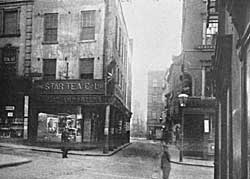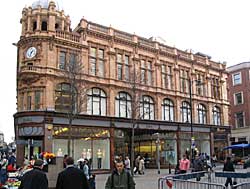< Previous | Contents | Next >

High Street in 1901 just prior to road-widening.
But this site of Fox's shop has still older associations and a very romantic story to tell. In 1754, when George II. was on the throne, the site was occupied by the stately home of Alderman Trigge who was the wealthiest Alderman that Nottingham had known. His house was set well back from the street and in front of it was a row of discreetly clipped elms and there was a great gate of beautiful wrought ironwork leading from the street into the forecourt. A verandah raised a foot or two above the ground stood in front of the house and there is a pleasant description preserved of how Alderman Trigge and his wife were wont to sit in their high-backed chairs on this veranda, he dressed in his plum-coloured velvet suit with diamond knee buckles and great silver shoe buckles and she in her gown of rich brocade with hooped petticoat and toupeed head-dress for an hour or two each afternoon when the weather was suitable, talking to their friends and watching the busy traffic of the High Street. They were blessed with two children, a boy and a girl, but the boy died in early manhood leaving his sister the sole heiress to Alderman Trigge's vast wealth. The worthy Alderman was enlightened beyond his times and provided his daughter with the most liberal education that the day could offer, this in itself being a miracle for his times, for in those days the idea that a commoner's daughter should want or should receive any education was not to be thought of. The girl seems to have added to her attractions extreme good looks and in due course she was courted by a certain Colonel Benton who was a scion of the aristocracy and was very wealthy. The whole arrangement was extremely happy and looked like making for a life of usefulness and pleasure for the two. But death stepped in and Colonel Benton died in tragic circumstances in his 22nd year, on the very day which had been selected as his wedding day. He left all his fortune to Miss Trigge, and the curious legacy of a new carriage which had been prepared for their wedding journey, and he showed his fondness for her by expressing a wish that when she married, as he felt sure she would, she would use this carriage on her wedding day. The poor girl was heart-broken, for the match was entirely a love match, and for months she secluded herself, but time is a wonderful healer and youth must have its fling so by degrees she took up her broken life and became some faint reflection of her former self. She must have been very charming for she attracted the attention of Lord Lyttleton an able and excellent man of great wealth and of considerable literary pretension. He was the friend and patron, for instance, of the poet Thompson. Eventually a marriage was arranged between these two and was celebrated with a tremendous amount of public rejoicing, for Miss Trigge was no less popular in the town than was the worthy old Alderman. Streets were decorated, true lover's knots were worn by high and low, and everybody was full of joy at the happy union of this girl whose tragedy had won the sympathy of everybody. The wedding procession to and from the church was a magnificent spectacle, but true to her first love Miss Trigge made the journey in the coach that he had left to her. It was drawn by four horses who wore great mourning cloths, the coachmen and coachman's box were dressed in the deepest mourning. Still this sad skeleton at the feast did not temper the ardour of the joy of the happy consumation, but perhaps only tended to emphasize it. Lady Lyttleton's after life was happy, so much so that she lived to be over 100 years old and in the course of her long and useful life saw no less than five Lord Lyttletons.
Just by this site stood until the alterations a great gabled house which our grandfathers knew as "The Elizabethan House." It is interesting because it was within its walls that 100 years ago a certain man called Josiah Corbett traded in toys. He took into partnership a young man called Beecroft and the business was afterwards removed to the corner of the Exchange and Smithy Row and has become a household word in the neighbourhood.
Of the postal history of High Street we said enough when we were considering Bridlesmith Gate, but High Street Place still remains and Messrs. Armitage Bros, still use the premises at the end of that little cul-de-sac which was erected for a Post Office in the early days of Nottingham's postal activities.
 This splendid Art Nouveau shop on High Street
dates from 1904 (A Nicholson, 2004).
This splendid Art Nouveau shop on High Street
dates from 1904 (A Nicholson, 2004).Messrs. Boots premises occupy the site of the "Blackamore's Head," which was probably the most aristocratic inn in Nottingham although I do not think that it did the most business. It must have been a great rambling place extending from what we call Pelham Street to High Street Place in the one direction and right up Pelham Street to opposite where Thurland Street now stands in the other direction. It had great folding doors leading into each of these streets and was complete with a great courtyard and all the appointments of a typical ancient inn. It has a certain coaching history, but we shall be able to consider the coaching story of Nottingham more fully when we get to the principal coaching inn of the town which stood elsewhere. The "Blackamore's Head" seems to have had a penchant for funerals. In 1778 the body of Mrs. Elizabeth Chaworth rested here for one night on its journey from London to Annesley. In 1787 the Duke of Rutland's body spent a night here en route from Dublin to Bottesford. Two years later in 1789 the Duke of Leeds's body lay for a night in one of its rooms on its way to Kniverton, near Rotherham, while, best known of all, in 1825 Lord Byron's body rested here for a night before interment at Hucknall, and these funerals of the aristocracy were by no means quiet affairs which could be conducted without disturbing the rest of the business of the inn. They included innumerable professional mourners, pall bearers, hearses and other panoply of woe which must have cast a sad gloom over the old inn.
But there are other memories of the "Blackamore's Head" which are not so gloomy. In 1763 it was within its walls that a meeting was held, at which it was decided to construct a turnpike from Nottingham to Helper, then an important manufacturing town, passing through Wollaton, Trowell and Ilkeston, and this meeting must have been attended by very wealthy individuals for no less a sum than £3,000, a huge amount for those days, was subscribed before the meeting broke up.
Of course Tobias must be reckoned with when considering the "Blackamore's Head," and sure enough we find him there in 1731. It was an important occasion in his life, for Coney with whom he was already acquainted fetched him from his inn one night and took him to the "King's Head" in Narrow Marsh where he was introduced to Turpin. This was the first meeting of the two scoundrels and led to all manner of evil. But the first night appears to have been spent in revelry which was cut short by the ominous fact that Turpin "had to mount at dawn."
In 1830 the old inn was sold by the Duke of Newcastle who was its owner, and has now completely disappeared, leaving nothing but the shadow of its name behind.
